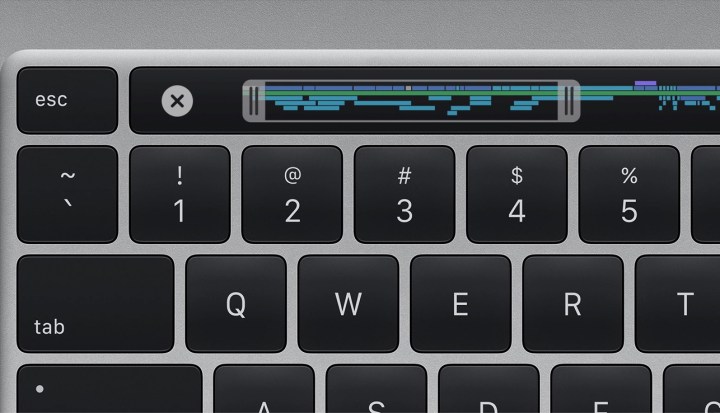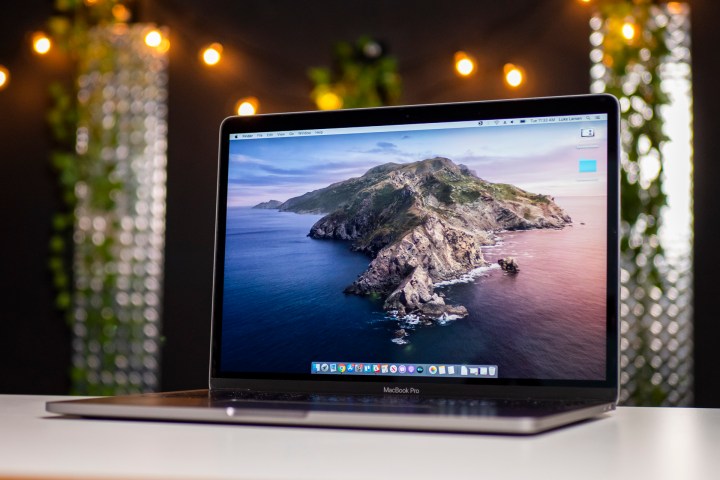The MacBook Pro is a beautiful, premium Apple computer and is one of the best laptops you can buy today. With its updated keyboard, special touch controls, and solid build, now is a great time to invest in a MacBook Pro if you were previously skeptical.
In this comparison, we pit the 13-inch model against its bigger 16-inch sibling. Their differences aren’t quite so wide as seen in years past, although the introduction of Apple’s new M1 chip makes the contest a bit more interesting. If you weren’t sure about which version to get, this comparison aims to help you decide.
Design

The biggest differentiator is in the screen size: One is 16 inches and the other at 13.3 inches (both diagonal). However, they’re not radically different in appearance other than their dimensions and weight.
With the bigger screen comes a bigger resolution. The 16-inch model comes in at 3072 x 1920 (226 ppi) with noticeably thinner bezels whereas the 13-inch model is 2560 × 1600 (227 ppi) with fatter bezels. Both have a peak brightness of 500 nits, support the P3 wide color gamut, and Apple’s True Tone technology, which matches the display’s white balance to the surrounding ambient light. Apple’s MacBook Pro screens have always performed superbly, so you should be happy with either of these, although the 16-inch model’s thinner bezels make it appear more modern.
Moving down to the keyboard deck, both units have Apple’s newer Magic Keyboard. The company ditched its problematic butterfly switches for a scissor design, leading to one of the best keyboards we’ve ever used on a laptop. The Magic Keyboard is complemented by Apple’s Touch Bar, an OLED strip that replaces the Function keys to add touch-based controls.
Immediately to the Touch Bar’s right is the Touch ID sensor mounted on the power button for password-free access and purchases. The large Force Touch trackpad for performing gestures in MacOS is one of the best you’ll find, too.
For ports, the two M1 13-inch starting points include two USB-C ports with Thunderbolt 3 and USB-4 support. The two higher-priced variants along with the 16-inch model, all of which use Intel chips, have four USB-C ports with
Despite all these differences, the two
They also share only two color options: Silver and Space Gray. If you want something fancier, you’ll have to upgrade to the newly redesigned iMac.
Performance

Performance is where these two
Apple changed the game with its 2020 refresh of the 13-inch MacBook Pro. The two starting points are based on its new Apple M1 System-on-a-Chip (SoC) combining eight ARM-based CPU cores (four performance, four power-efficient) and eight GPU cores. This is notable not only because it sees Apple jumping the Intel chip but because the M1 doesn’t natively run Intel-based software.
That said, you may see a performance issue when using this software, as it runs on an emulator, called Rosetta 2, that’s built into MacOS Big Sur. This performance drop may only be temporary, however, until the developer releases a version that runs natively on Apple’s M1 chip. Apple made an identical move when it shifted from IBM to Intel in the mid-2000s.
However, Apple also offers two starting points with Intel’s 10th-gen Core i5-1038NG7 and Core i7-1068NG7 four-code processors. These Intel-based models support 16GB or 32GB of
Of all three chips, Apple’s M1 provides the best base performance on paper, surpassing the two Intel chips in single- and multi-core benchmarks. It’s also an eight-core chip versus Intel’s two four-core chips.
The 16-inch model, meanwhile, packs more performance due to its larger size. More specifically, the ninth-generation Intel chips boast desktop-class performance in a notebook design. The $2,399 starting point begins with the Core i7-9750H whereas the $2,799 model has the Core i9-9880H. Both can be configured with the Core i9-9980HK.
The real kicker here is that the 16-inch model also supplies discrete graphics from AMD. The $2,399 model starts with the Radeon Pro 5300M (4GB) but can be configured with three others, depending on what you need graphics-wise: the Pro 5500M (4GB), the Pro 5500M (8GB), and the Pro 5600M (8GB). The $2,799 model starts at the Pro 5500M (4GB) but can be configured with the same options.
With all that hardware, the 13-inch model can’t compete in terms of AutoCAD designs, video editing, and other graphics-intensive applications. The 16-inch model with the Core i7 and Pro 5300M GPU is the bare minimum we would recommend. Apple promises even more power thanks to its new cooling system introduced in the 16-inch model, so it can only go up from here.
As for gaming, the MacBook Pro 16’s dedicated graphics card will make a huge difference. Not only does having a stand-alone
Ultimately, if you need a powerful machine, then the MacBook Pro 16 is the one to get.
Portability

There are two things to consider when deciding which laptop is the more portable: The physical size and weight of the device, and how long its battery can last. There’s no point getting a thin and light device that dies in just a few hours, after all.
But let’s face it before we even dive into the numbers: The 13-inch model is the more portable unit of the two. It measures 11.97 × 8.36 × 0.61 inches and weighs 3.0 pounds. What’s interesting is that the 16-inch model is a tad thicker at 0.64 inches, and it’s a heftier 4.3 pounds. It’s wider and deeper too at 14.09 and 9,68 inches, respectively. That said, the 16-inch model’s design could make quite a difference when you’re carrying your laptop around in a backpack all day.
However, this isn’t just a cut-and-dry win for the MacBook Pro 13. It may be slimmer and lighter, but it also has the smaller 58WHr battery across the board. The factor to keep in mind here is the M1 chip, as ARM’s CPU core design is optimized for performance while sipping on the battery. That’s why it’s used by Qualcomm, Samsung, and even Apple in chips targeting smartphones and tablets.
Apple claims that the MacBook Pros packed with its M1 chip can last up to 17 hours of web use and up to 20 hours of Apple TV playback. On the Intel-based units, both numbers drop down to 10 hours. Meanwhile, the 16-inch model has a larger 100WHr battery which Apple claims will last 11 hours of web browsing or Apple TV video.
When we tested the Intel-based MacBook Pro 13, we averaged around 6.5 hours in a typical workday flow. The M1 version, we found, was closer to Apple’s claims: Over 16 hours in our web browsing tests and over 21 hours in our video loop test. That’s a massive difference between the two MacBook Pro 13 designs.
Unfortunately, the performance of the 100WHr battery in the 16-inch model wasn’t exactly stellar, but instead was a reflection of what’s inside. This laptop includes a desktop-like CPU, a discrete GPU, and a 16-inch screen with a near
The MacBook Pro 16 is still a powerhouse

We’ve been disappointed with the MacBook Pro for a few years now. From the uncomfortable keyboard to the lackluster components, it’s often felt hard to justify the cost when there is so much competition in the laptop market.
But that’s all changed. From the new Magic Keyboard to Apple’s slow departure from Intel, the company seemingly understood all the woes and invested solely in making the MacBook Pro really great again.
The company’s lineup is certainly compelling. The 13-inch model offers high portability and two powerful starting configurations based on its new M1 chip. This design may lower Intel-based desktop software performance for now, but the tradeoff is the best battery performance we’ve seen in a long while. The Intel models, it seems, aim to provide more
The
The pricing isn’t cheap although you get a lot of bang for your buck with the entry-level MacBook Pro 13 at $1,299. That lands you the M1 chip, 8GB of
The 16-inch model starts at $2,399 for the Core i7-9750H, Radeon Pro 5300M, 16GB of
The bottom line with this comparison, then, is this: How big do you want to go, and what are you willing to spend?
Editors' Recommendations
- The XPS 16 is fighting an uphill battle against the MacBook Pro
- MacBook Pro 16 vs. MacBook Pro 14: The important differences
- Best refurbished MacBook deals: Get a MacBook Air for $140 and more
- Best MacBook deals: Get an Air for $605 and save on M3 MacBook Pro
- Best Apple deals: Save on AirPods, Apple Watch, iPad, MacBook




